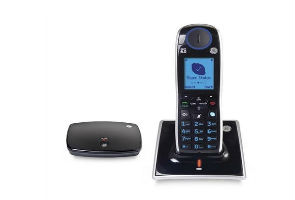 With two new products, Skype has made it easier to make Internet calls from home phones, for savings on international calls and potentially also domestic ones.
With two new products, Skype has made it easier to make Internet calls from home phones, for savings on international calls and potentially also domestic ones.But compared to other Internet calling options for the home, Skype's solution is a piecemeal and complicated way to save money. All the same, some Skype fans may appreciate the new cordless phone with a built-in Skype function.
We tested the phone along with the new Freetalk Connect-Me phone adapter, which Skype sells for $40. That price includes an hour calling. For an additional $20, you can get free calls to the U.S. and Canada for a year. Calls to people on Skype (as opposed to those reached by dialing a number) are free, no matter where they are.
The adapter is a small box that plugs into a power outlet. You connect cables to your Internet router, your phone jack and your home phone.
When you make a Skype call, the adapter diverts the call from the external phone line to your Internet connection. But first you have to pre-program the adapter to recognize certain speed-dial numbers as corresponding to Skype contacts or phone numbers. Since it's truly a "black box" - with no buttons or screen - you reach it through your computer's Web browser.
This clunky setup prevents you from making impromptu Skype calls. Because your phone isn't designed to work with Skype, you can't access your Skype address book directly on the handset, or see who's online to take your calls. Since home phones don't have cameras, you won't be able to do video calls.
On the plus side, the phone lets you receive Skype calls at any time, without having your computer on.
But what really sinks the Skype adapter in my esteem is the sound quality. On calls to international and domestic phones, there were odd hissing noises in the background and voices were muffled. One person I called heard her own echo, a common phenomenon on poorly configured Internet phone systems.
The audio improved greatly, to the level of a good cellphone call, when I ditched the adapter for the other recent Skype release, the GE Digital Cordless Expandable phone. It costs $70 with 400 minutes of calls thrown in. For another $20, you get a year of calls to the U.S. and Canada and 200 minutes of calls to international phones.
It looks like any cordless phone, except it has a prominent "Skype" button. It can make and receive regular phone calls, and the buttons and screen make it a lot easier to make Skype calls than it is with the adapter. The phone shows you which of your Skype contacts are online, and when you dial a number, you can choose whether to route it through Skype or the phone company.
It sounds good to be able to choose between the boring old phone company and the jazzy new Internet guerrilla for every call. But how much money will that really save you?
Most plans from phone and cable companies already include unlimited domestic calling, so there isn't much point to running those over Skype. Their international rates, though, are good. And of course, calls to Skype contacts are free.
But if you call the same few people overseas over and over again, and they're not big Skype users, there's another way of making cheap Skype calls from your home phone, without the use of an adapter or special phone. You can sign up for the To Go service on Skype's website. If you give it an international number that you like to call, it will give you a local number back. Call that number from your home phone, and Skype connects your international call at its rates, rather than the phone company's. It's like a calling card, but without the hassle of entering a bunch of numbers on the phone. (A competitor called Rebtel has a similar service.)
The drawback to Skype To Go is that you can only call phone numbers - it won't connect you to Skype users for free.
Now, it looks like you could reap some really big savings by eliminating your home phone service altogether in favor of the Skype phone or adapter. After all, Skype charges about as much for a year's worth of service as a phone or cable company does for a month.
But Skype isn't set up as a replacement for a landline, and points this out at every opportunity. For one thing, you can't call 911 on it. Also, Skype doesn't give you a phone number, unless you pay another $18 per three-month period. Without a phone number, you can make outgoing calls, but you can't receive them. The exception would be any Skype call routed to your username. Try giving that to the doctor's office! And even if you pay for a phone number, it will be a new one - you can't move your existing home number over to Skype.
See what I mean about a piecemeal solution? It's like you have to pay for every little piece of the puzzle.
To really break free from the phone or cable company, you need a full-service Internet calling product, like those sold by Vonage Holdings Corp. or Ooma. Both support 911 calls, and let you move over your phone number. Ooma's sound quality is practically indistinguishable from a regular landline.
Skype is a victim of its limited ambitions when it comes to home phone service. It wants to be an Internet phone company, but doesn't want to bother with all the regulation and nitty-gritty details that come with the "phone company" part. It will be interesting to see if Microsoft Corp., which is planning to buy Skype for $8.5 billion, will take it in a different direction.

0 comments:
Post a Comment